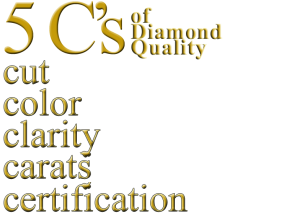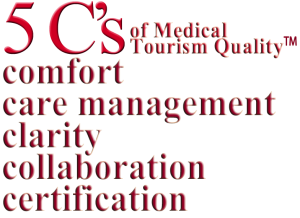 To be successful in the medical tourism business – not just successful but outstanding – there are five essential building blocks around which to structure your business.
To be successful in the medical tourism business – not just successful but outstanding – there are five essential building blocks around which to structure your business.
No matter if you’re in a hospital or clinic or working in a medical tourism company, if you want to bring medical tourists to your facility or are sending medical tourists abroad for treatment in another country, put your medical tourism program on a path to success by using these five building blocks.
Creating a great hospital, treatment center or clinic for medical tourists and delivering great service to medical tourists is like creating a fabulous diamond.
As a consumer, to be sure we are buying a fine quality diamond, we judge it by its 4 Cs, cut, color, clarity, and carats. Some add a fifth C, certification.
A diamond starts out as an ordinary lump of carbon. This is its foundation.
 A strong clinical practice and great customer service are the foundation of a medical tourism program, the lump of carbon. How do we turn this lump of carbon into a great hospital, a great specialty center or a great company for medical tourists?
A strong clinical practice and great customer service are the foundation of a medical tourism program, the lump of carbon. How do we turn this lump of carbon into a great hospital, a great specialty center or a great company for medical tourists?
A great medical tourism program is built on 5 supporting blocks that not unlike the 5 Cs of purchasing a great diamond.
The 5 C’s of great medical tourism service are comfort, care management, clarity, collaboration, and Guide To Medical Tourism Certification.
-
The first C of a great medical tourism program is comfort.
Comfort – the sparkle, the cut of the diamond – is what most hospitals and most medical tourism facilitators sell. Most hospitals continue to treat medical travelers as if they were ordinary patients.
They act as if patients were hotel guests, promoting 5-star hotel amenities, wifi service, private rooms, a customer service department or concierge that helps with flights, tours and visas.
Yet we know medical tourists are not ordinary patients, and that these hotel-like comforts have very little to do with ensuring that medical tourists have the good care that produces good medical outcomes.
It’s quite easy to create a hospital’s sparkle, or a medical travel company’s sparkle, to put resources into physical comfort, a fancy website or services that provide comfort.
This works because research continues to show that all over the world most patients and their families judge the quality of clinical care they receive on mostly non-clinical care items.
There are two sides to providing “comfort”.
Comfort is not only about the pretty things. We can give comfort, and we also need to take away those things that deny comfort. We deny comfort if we don’t pay attention to safety, security and privacy measures.
Most hospitals conduct fire drills and evacuation drills from time to time and believe this is enough. But patient safety is more than a fire drill. It’s the safety of the patient in the room, on the ward and in the treatment rooms. Are there closed circuit cameras; are there special pass code protected areas of the hospital? Is personal information collected and kept securely in the hospital or online?
Beyond comfort are the other C’s – ones that are more important for the ultimate wellbeing and good outcome of a medical tourist.
-
The second C of a great medical tourism program is care management.
It reflects our desire that care and treatment for the medical tourist be smooth and seamless. It’s equivalent to the color of the diamond – the best diamond is without seams, smooth, and colorless. In other words, unremarkable.
This is care management – a process that works smoothly and without notice every time.
Creating an integrated, seamless, colorless process is quite a bit more challenging than providing comfort, or sparkle. Care management may be the most critical factor in determining the best outcome for a medical tourist. It’s how you as a health care professional accommodate the needs of a medical tourism patient.
Care management begins before the medical tourist has even left home. Before a patient or client begins traveling, there is a need to get information – medical records, diagnosis, medical history. And to give information like pre-surgery instructions.
On site, as the patient goes through hospital intake, surgery, and recovery, care management may include arranging for a second opinion, assisting with complicated scheduling, monitoring a patient in his room overnight, or making sure dietary and medication needs are met.
Once the patient is discharged from the hospital, care management involves monitoring the patient’s recovery so there are no surprises further down the road.
And of course, care management continues as the patient returns home, to make sure that any ongoing care if needed is properly transferred to the doctor at home and continued.

Hospitals and doctors often believe that their customer service staff can take on the care management role. This is a mistake. Customer service, marketing or international patient staff can only truly represent their employer – who is the hospital or the doctor – They cannot properly represent the patient.
Complete care management of a medical tourist is one-on-one, with a dedicated person accepting responsibility for that patient’s ongoing wellbeing and acting as the patient’s representative or the patient’s advocate.
-
The third C of a great medical tourism program is clarity.
For a diamond, clarity is transparency.
For a medical tourism program, clarity is clear communication. It is not up to the patient to understand the hospital staff. It is up to the hospital staff to make sure they understand the patient.
Clarity is also transparency.
Health care transparency is visibility into the quality of your health care services.
Transparency provides consumers with the ability to see specific information on costs, quality and success of your medical services.
Transparency means timely and full disclosure to the medical tourist including any ethical or moral consideration involved in the treatment and care, or any conflicts of interest.
Medical travelers should have certain rights and you must understand and respect these rights.
-
The fourth C is collaboration.
It’s the team you bring together, who you work with in order to provide seamless integrated care management. The stronger your team, inside and outside your institution, the more power you bring to your medical tourism program.
Collaboration, inside your institution, is interdepartmental relations, training and education. It includes technicians, pharmacists, dieticians, doctors, nurses and hospital executives as well as customer service, international patient staff, and marketing.
Collaboration, outside your institution, refers to your partnerships and alliances and your care network. This changes from time to time but likely includes the provider institution, the doctors and nurses, the facilitator or care manager, and sometimes the embassy, the hotel, the travel agency, the airline, health insurance provider, visiting nurse service, or translator.
Often the medical travel facilitator is the one who coordinates this care network.
-
The fifth C is certification.
Certification is the recognition that you have successfully put into practice the 4 Cs that are the heart and soul that make your hospital, clinic or service great for medical tourists.
Many people confuse accreditation and certification.
Accreditation like JCI, Trent, Accreditation Canada and others review standards of clinical excellence. None of them provide any extra assurance that the accredited institution can manage the special care requirements of medical tourists or international patients.
Medical tourism certification from the Medical Travel Quality Alliance reviews your medical tourism processes, services and operations against international standards of care and quality specially for medical tourists.
It’s the medical travel circle of care that partners with, wraps around, and amplifies clinical excellence.
Medical tourism certification that reviews your operations is not at all like the programs that offer individual certification or credentialing through education or online courses.
You may gain more knowledge about medical tourism or international patient care and be a more desirable employee.
To assure health care consumers that a hospital or business operates in a safe and secure fashion and yields good outcomes for medical tourists, or that a medical tourism company takes a responsible approach to its work must be demonstrated by a mark or symbol of quality.
An international mark of quality such as MTQUA medical tourism certification lets health care consumers know they are receiving safe and quality treatment and care as good as or better than what they would have received at home. They know it is managed appropriately for their cultural, social, medical, emotional and physical needs and gives the best chance for a great outcome.

 >
>
One Response to The 5 Cs Of Delivering Brilliant Medical Tourism Services